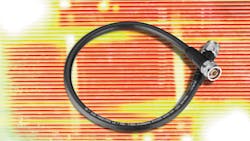Low-Smoke Microwave Cable Assemblies Keep Sailors Safer
The Overview
In its PhaseTrack Low Smoke (PTLS) microwave cable assemblies, Times Microwave Systems delivers assemblies that are qualified for shipboard applications. The assemblies provide exceptional phase temperature performance up to 85ºC and offer the same low-smoke, zero-halogen (LSZH) jacket used on Times’ QPL M17 cables for easy cross-reference and qualification.
Who Needs it and Why?
Low-smoke, zero-halogen cable assemblies are essential in confined spaces where air exchange is minimal: places such as onboard ships and submarines, where large amounts of cable reside in close proximity with personnel and/or sensitive electronics. Fire is among the greatest dangers in these environments, as accumulating smoke can obscure visibility for safe evacuation. When burned, low-smoke cables emit a less optically dense smoke that releases at a lower rate, making it easier for occupants to exit and protecting the safety of firefighting operations. Halogen-free materials also produce clearer, whiter smoke for better visibility and do not emit halogen’s toxic off-gases.
Under the Hood
The PTLS assemblies are available in sizes from 0.2” to 0.6” and address all frequencies from HF through K-band, including a variant optimized for minimum loss in the Ku-band. Cable assemblies can be supplied with any type of industry-standard RF interface. The assemblies incorporate the proprietary TF5 dielectric for a low-loss, flexible, and phase-optimized cable. Its stability is superior to PTFE and is free of its notorious “knee.”
About the Author
David Maliniak
Executive Editor, Microwaves & RF
I am Executive Editor of Microwaves & RF, an all-digital publication that broadly covers all aspects of wireless communications. More particularly, we're keeping a close eye on technologies in the consumer-oriented 5G, 6G, IoT, M2M, and V2X markets, in which much of the wireless market's growth will occur in this decade and beyond. I work with a great team of editors to provide engineers, developers, and technical managers with interesting and useful articles and videos on a regular basis. Check out our free newsletters to see the latest content.
You can send press releases for new products for possible coverage on the website. I am also interested in receiving contributed articles for publishing on our website. Use our contributor's packet, in which you'll find an article template and lots more useful information on how to properly prepare content for us, and send to me along with a signed release form.
About me:
In his long career in the B2B electronics-industry media, David Maliniak has held editorial roles as both generalist and specialist. As Components Editor and, later, as Editor in Chief of EE Product News, David gained breadth of experience in covering the industry at large. In serving as EDA/Test and Measurement Technology Editor at Electronic Design, he developed deep insight into those complex areas of technology. Most recently, David worked in technical marketing communications at Teledyne LeCroy, leaving to rejoin the EOEM B2B publishing world in January 2020. David earned a B.A. in journalism at New York University.

